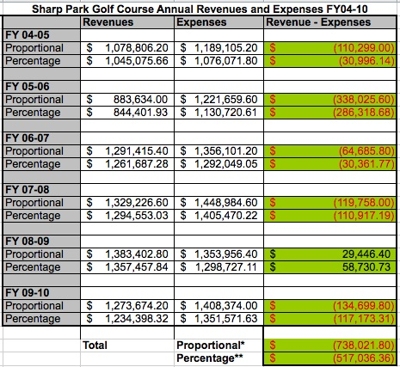Another 100K Down the Drain at Sharp Park Golf Course
November 16, 2010
FOR IMMEDIATE RELEASE
CONTACT: Brent Plater, Wild Equity Institute, 415-572-6989
Another 100K of Public Dollars Down the Drain at Sharp Park Golf Course
San Francisco taxpayers billed a half-million dollars
over the past six years for controversial San Mateo County golf course
SAN FRANCISCO— A new analysis of documents recently released by San Francisco’s deficit-ridden Recreation and Parks Department shows that Sharp Park Golf Course lost between $117,000 and $135,000 last fiscal year, bringing the golf course’s total operating losses to at least a half-million dollars since 2004.
“No community center or neighborhood park should have services reduced while the Department is subsidizing suburban golf in San Mateo County,” says Brent Plater, Executive Director of the Wild Equity Institute. “We deserve better: it’s time to close Sharp Park Golf Course and bring the funds saved back to San Francisco’s communities, where the money rightfully belongs.”
The analysis likely under-estimates losses because it does not include recent capital expenditures, such as the $300,000 San Francisco taxpayers paid over the past two fiscal years to install new pumps and repair pipes at the chronically-flooded golf course.
The Department’s own analysis shows losses of over $630,000 between 2005 and 2009.
Sharp Park Golf Course is owned and operated by the City and County of San Francisco but located in Pacifica, California. The golf course has illegally killed two endangered species for several years. Both species — the endangered San Francisco garter snake and the threatened California red-legged frog — require aquatic habitats to survive, but the golf course’s new water pumping system can drain these habitats more rapidly, putting both species at risk of further harm.
The Wild Equity Institute is working with dozens of community, park, recreation, historical, and environmental groups to eliminate San Francisco’s expenditures at Sharp Park while building a better public park on the land in partnership with the National Park Service. Go to wildequity.org to find out more about our plan to save San Francisco money, protect the environment, and provide recreational opportunities everyone can enjoy.

*Apportions unallocated revenues and expenses to each golf course equally.
**Apportions unallocated revenues and expenses to each golf course according to size.
Today’s calculations were made using the City’s own golf fund data. To prevent double-counting, subsidies from other taxpayer funds were removed from Sharp Park’s revenues: these are transfers, not true revenue generation. Similarly, subsidies to other taxpayer funds were removed from the analysis. “Unallocated” funds—revenues and expenditures that benefit more than one golf course—were apportioned to each course using two methods. In the first (proportional) method, unallocated revenues and expenditures were apportioned equally to each golf course managed by the Recreation and Parks Department. In the second (percentage) method, unallocated revenues and expenditures were apportioned to each golf course according to the golf course’s contribution to the golf fund. As seen above, both methods showed substantial annual losses at Sharp Park Golf Course.
The Wild Equity Institute is building a healthy and sustainable global community for people
and the plants and animals that accompany us on Earth.
https://www.wildequity.org/
###

Leave a Reply
Want to join the discussion?Feel free to contribute!